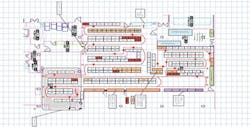ABCs on storage redesign from ABC
Two Supply Chain executives from one of the leading pharmaceutical and medical/surgical supply distributors in the nation, shared their blueprint for redesigning an organization’s storage footprint that integrates pharmaceuticals with med/surg supplies as part of a self-distribution model.
Mitch Wood, R.Ph., Managing Director, Pharmacy Consulting Practice, Pharmacy Healthcare Solutions, AmerisourceBergen Corp.
“We are very passionate about the general notion of ‘form following function,’ meaning that completion of many up-front modeling and due diligence processes are critical, and actually drive layout and space design considerations.”
Front-end planning, modeling and financial due diligence is essential to the success of any health system self-distribution project. A thorough planning process to clearly identify capital and operating expenses of the startup and future life-cycle is required to support a viable operation.
A full legal/regulatory review of site renovation / acquisition planning with consideration for purchasing of drugs at desired class of trade pricing must be undertaken. Facility ownership, non-profit tax status, licensure, certifications, interstate commerce and many other considerations must be reviewed by counsel retained by the entity.
Site selection should include a review of upfront and ongoing build versus lease costs, and the potential for economies of “shared” infrastructure. The potential for use of selected facility “vertical” storage space to take full advantage of “cubic” dimensions is a key design factor.
Form truly follows function, and the initial configuration model of Pharmacy services and drug formulary SKUs must be carefully designed, understood and subjected to pro forma and operations analysis. The selected model will then drive the business and site design requirements planning, space allocations, preliminary layouts, phasing, and key process integration points, as well as equipment and automation. Flexibility of design for capacity planning, service phasing and efficient process reconfiguration is key.
Integration of drug self-distribution with those of med/surg supplies must recognize the fundamental distinctions of the product. This invokes special considerations throughout the product ordering, handling and logistics life-cycle
Environmental controls for drugs, including cold chain and the facility “Operations Clock” for 24/7/365 process coordination
Chain of custody control and documentation considerations, DSCSA compliance for distribution facility and served sites
System-wide Inventory Management System deployment to allow drug inventory monitoring, and agile rebalancing and dynamic PAR revisions over time
Security of drugs and drug totes, including facility receiving, pre-distribution inventories, and fulfilled orders awaiting shipment.
Wholesaler versus Direct Manufacturer sourcing of drugs: Is this a selective consolidation of targeted drug lines (i.e., high-cost drugs, repackaging, etc.) or an “all in” approach, or full self-distribution?
Will the facility distribute controlled substances? Thorough consideration of formulary SKUs and volumes is needed for compliance, avoiding diversion and accurate expense and operations planning for vaults, software, equipment, personnel and training, and end-to-end.
Planned services should focus on returned value, and whether handling an item at the facility improves unit cost, system-wide efficiency, or simply adds overhead by cross-docking.
Comprehensive, integrated Procure-to-Pay (P2P) systems, and warehouse management system (WMS). The WMS must successfully address and support pick, pack-and-ship (PPS) operations, as well as directly provide a platform for site-ordering /receiving, or interface to a pharmacy–specific system providing these functions. A traditional, legacy Pharmacy IMS may not provide sufficient functionality as a platform.
Tote cleaning and washing should be considered for both in terms of process flows and facility design location.
Make versus Buy logistics: Ship with your own truck lines versus a contracted third-party logistics (3PL) company versus the U.S. Postal Service, FedEx, UPS or some combination.
How and by whom are drug totes aggregated with med/surg totes for efficient distribution and transfer of ownership at each receiving site?
What are the necessary steps to ensure appropriate environmental, handling, and security steps are taken in route and at receiving points?
Backup/service interruption planning is an essential element that can be overlooked. Having and testing alternate sourcing, logistics, and infrastructure plans to deal with everything from icy roads, to power failures, and loss of internet or communications service.
Assign a dedicated project management [office] (PMO) to this effort. This resource pool will need to consist of team members from each department that is planned to use or oversee this space and should also include finance, compliance, quality and risk management.
Build business capacity models that identify the cubic velocity of the merchandise you plan to store in reserve and how you plan to pick from an active location if applicable. This can influence the type of storage and retrieval systems you can choose from and your return-on-investment should account for not only the equipment but also the cost of the square footage and labor rate.
If you are planning to ship from a central location, packing supplies can account for up to 10 percent of your facilities space if you are using Styrofoam shippers, totes, pallets, cooler boxes, corrugate and packing materials. Vendor partnerships can assist by providing consignment inventory storage to help reduce this impact.
Check with the “A’s” as in DEA, DSCSA, OHSA, NFPA, ADA, Architect, Legal Authorities. They simply can influence the design of the area you are looking to outfit from a security, processing, safety, fire protection, seismic and local code having jurisdiction. For instance, some jurisdictions will require elevators to access work platforms for assisting team members with disabilities.
Take advantage of facility cube (low-to-high, wide-to-narrow), especially if space is limited. However, you should evaluate the ROI on the material handling equipment concepts based on the type of material handling equipment selected, labor and square footage occupied.
Minimize your process travel paths and balance your product velocity in pick zones to ensure process fluidity.
Standard Operating Procedures for all processes can simplify the on-boarding and mentoring of new associates.
Don’t skimp on lighting in quality, picking and other areas of detail or where review of written material occurs.
Ergonomics is real. Ensure workstations are well equipped, adjustable and pick area design can accommodate a variety of team member heights without over-extending, bending or exertion. Fixed position workstations can be accommodated with adjustable floor to change working height to improve associate posture, such as goods-to-man pick stations.
If new or existing docks with levelers are in place, look to deploy dock locks/restraints and wheel chocks for the safety of the associate during times of loading and unloading of trailers.
Work with industry providers or consultants to evaluate the best technology for processing material in-and-out of the area, including voice technology, 2-D scanning technology, vision technology, etc. Ensure your warehouse management system (WMS) is capable of integration and that access points in the facility provide the correct coverage.
Ensure your WMS meets company audit requirements when it comes to physical inventory and routine cycle counting.
If conveyance is needed in your solution, compare the benefits and cost of a zone-routing solution versus a “pick-n-pass” solution. Your design volume will likely decide where this break-point exists.
If considering an off-site storage facility, identify up front the items you plan to store in an off-site location as the regulations, and in some cases licensing, can be impacted whether you are storing pharmaceuticals versus medical devices, [over-the-counter drugs], [hazardous biological agents] or process supplies.

